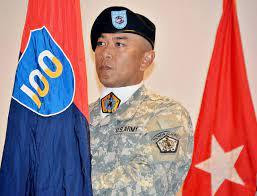Home » 100th Division Lineage and Honors
100th Division Lineage and Honors
 The The 100th Division was constituted 23 July 1918 in the National Army and organized 29 October 1918 with Headquarters at Camp Bowie, Texas, less the 199th Infantry Brigade that was to be organized in France. Under War Department orders of 19 October 1918, BG William B. Cochran was assigned to command the 100th Division at Camp Bowie, Texas. He was also the Commander of Camp Bowie, Texas. The division would have three brigades: the 199th Infantry Brigade, the 200th Infantry Brigade and the 175th Field Artillery Brigade. From the Army Almanac 1959, a listing of the Army generals, it appears that General Cochran was promoted to Brigadier General 1 October 1918 and served in that rank until 30 November 1922.
The The 100th Division was constituted 23 July 1918 in the National Army and organized 29 October 1918 with Headquarters at Camp Bowie, Texas, less the 199th Infantry Brigade that was to be organized in France. Under War Department orders of 19 October 1918, BG William B. Cochran was assigned to command the 100th Division at Camp Bowie, Texas. He was also the Commander of Camp Bowie, Texas. The division would have three brigades: the 199th Infantry Brigade, the 200th Infantry Brigade and the 175th Field Artillery Brigade. From the Army Almanac 1959, a listing of the Army generals, it appears that General Cochran was promoted to Brigadier General 1 October 1918 and served in that rank until 30 November 1922.
The 199th Infantry Brigade was to be organized in France consisting of the 397th Infantry and the 398th Infantry which were constituted in the National Army 23 July 1918 and the 374th Machine Gun Battalion. The 397th Infantry was to be organized from the 56th Pioneer Infantry and the 398th Infantry was to be organized from the 57th Pioneer Infantry. The organization was never accomplished.
The 199th Infantry Brigade was constituted in the Organized Reserve 24 June 1921 and organized December 1921 with Headquarters at Huntington, WV. Location was changed 27 October 1931 to Parkersburg, WV. Headquarters and Headquarters Company (HHC) was converted and redesignated 23 February 1942 as the 100th Reconnaissance Troop (less 3rd Platoon) and assigned to the 100th Division. HHC 200th Infantry was concurrently converted and redesignated as 3rd Platoon, 100th Reconnaissance Troop. Ordered into active military service 15 November 1942 at Fort Jackson, SC the unit was reorganized and redesignated as the 100th Cavalry Reconnaissance Troop.
The 200th Infantry Brigade was to consist of the 399th Infantry and the 400th Infantry were constituted in the National Army 23 July 1918 and the 375th Machine Gun Battalion, but were never organized.
The 175th Field Artillery Brigade was to consist of the 373rd Field Artillery, 374th Field Artillery, the 375th Field Artillery and the 25th Trench Mortar Battery. The artillery units were never organized. The Trench Mortar Battery was organized in August 1918 at Camp Stanley, Texas and assigned to the Brigade but never joined.
Division Troops were to consist of the 373rd Machine Gun Battalion, 325th Engineers, 625th Field Signal Battalion and Headquarters Troop, but were never organized.
Division Trains were to consist of the 373rd Train Headquarters and Military Police, 325th Ammunition Train, 325th Supply Train, and the 325th Sanitary Train (which would include the Ambulance Companies and the Field Hospital), but were never organized.
The division organization did not progress beyond formation of the Division Headquarters and preparations for the reception of personnel at Camp Bowie, Texas. On 30 November 1918, the War Department directed demobilization of all commissioned and enlisted personnel.
The 100th Division was reconstituted 24 June 1921 in the Organized Reserves, organized 27 September 1921 with Headquarters at Charleston, WV. Division Headquarters was relocated to Huntington, WV, on 24 February 1924 and then returned to Charleston, WV on 6 August 1937.
The division contained both the 399th and 400th Infantry located in Kentucky prior to World War II. MG (then 2LT) Benjamin J. Butler, BG (then 1LT) Bodley Booker, Jr. (in 1936) and COL (then 1LT) William DeHaven were assigned to the 399th Infantry, along with several other officers. On 25 March 1940 the 400th Infantry was commanded by COL G. D. Caldwell and LTC F. Moss was the Executive Officer. The unit’s address was 444 Post Office Building, Louisville, KY. It contained six battalions of four companies each, a Regimental Headquarters and a Regimental Headquarters Company. Companies were numbered beginning with “A” through “Z” with the exception of “J” and “U”. BG (then 2LT) Bodley Booker, Jr. was later reassigned to the 400th Infantry and was invited to attend National Defense Dinner (forerunner of the Louisville Armed Forces Day Dinner) on 6 April 1939 at $1.25 per person.
The division was ordered into active military service 15 November 1942 and reorganized as the 100th Infantry Division at Fort Jackson, SC with MG Withers A. Burress as Commanding General. Activation of the 100th Infantry Division marked the first time in the history of Fort Jackson that a new division was activated there. When the 100th Infantry Division was activated, it marked the first time in the history of the United States that the Army had reached the century mark in the number of infantry division designations. The division was inactivated after World War II on 10 January 1946 at Camp Patrick Henry, VA.
The division was redesignated as the 100th Airborne Division 15 October 1946 assigned to Second U.S. Army and activated on 23 October 1946 with Headquarters at Louisville, KY in the Organized Reserve. It was redesignated and reorganized as 100th Infantry Division 12 May 1952. The division was again redesignated and reorganized on 17 April 1959 as the 100th Division (Training).
The division was ordered into active service on 25 September 1961 in Kentucky with duty station first at Fort Polk, LA and then changed to Fort Chaffee, AR and then released from active service on 15 August 1962 and reverted to reserve status.
On 1 October 1977, the division’s training mission was changed from Infantry to Armor.
The division was again redesignated on 1 October 1994 as the 100th Division but was not reorganized.
The Organized Reserve was redesignated as the Organized Reserve Corps 25 March 1948 and redesigned as the Army Reserve on 9 July 1952.
Initially as a reserve unit, the division was assigned to Second U.S. Army 16 October 1946, transferred to First U.S. Army 1 January 1966, then reassigned to Fifth U.S. Army 1 October 1973, then transferred to Second U.S. Army 1 October 1983. The division currently served directly under the U.S. Army Reserve Command.
References:
· The Army Lineage Series, Armies, Corps, Divisions and Separate Brigades, dated 1993
· Order of Battle of the United States Land Forces in the World War, extract of Volume 3, Part 2, dated 1988, from the Center of Military History, U.S. Army.
· A directive dated 23 July 1918, declassified 31 May 1973, signed by General Peyton Marsh, quoting a cablegram #1447 of 3 June 1918 from the Secretary of War.
· The Century Sentinel, November 1943 issue.
· Armies, Corps, Divisions and Separate Brigade, the Center for Military History, 1987 and the Infantry Regiments of the U.S. Army, 1982.
(Webmaster’s Note: COL Edwin K. Adam wrote this article 21 November 1999. He was the curator of the Century Division Historical Holding Center. Colonel Adam died suddenly 12 July 2000.)
For an excellent summary and Story of the 100th Infantry Division click this link:
https://www.lonesentry.com/gi_stories_booklets/100thinfantry/index.html
Should you have information that you can contribute to this page, please contact us.

